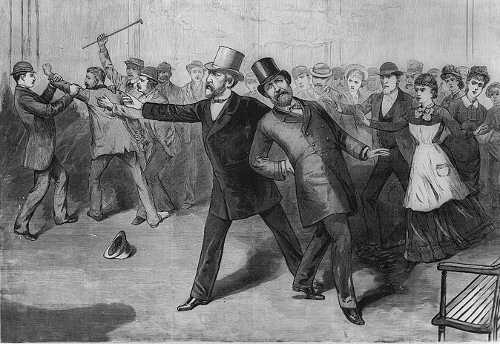
French explorers, Presidential assassinations and wartime cutbacks. This week is history was certainly a busy one.
Jan. 15, 1680
By the end of the 17th century, North America still remained largely unexplored.
The Spanish in modern-day Mexico and Florida, the French in modern-day Canada and the English along the eastern seaboard had established for themselves colonial toeholds in the New World.
No one knew for certain the expanse of the continent and the colonial holdings of these great empires remained largely isolated from one another, especially those between France and Spain.
All of this changed when one man, René-Robert Cavelier, Sieur de La Salle, undertook a mission of exploration.
La Salle had made the journey from France to the New World as a Jesuit missionary but quickly traded the vestments of a Catholic priest for those of a freelance adventurer, citing “moral weaknesses” as his reason for leaving the Church.
By this time, the Catholic Seminary of St. Sulpice had laid claim to land on the island of Montreal and was actively looking for settlers to buffer the Church from the sometimes-aggressive natives.
Not many men were willing or able to undertake such a risky venture, and so the Church was all-too happy to grant land to the one-time missionary.
La Salle soon built a settlement on his newly-granted land and made nice with local tribes of the Mohawk.
It was from these interactions that the Frenchman first learned of a great river that ran into yet a larger river, which in turn emptied its waters into the ocean to the south.
La Salle was convinced that he had found the elusive river that would lead him to China. Yes, even 100 years after Columbus’ failed attempt to find a westward route to the Far East, explorers were still convinced such a waterway existed.
Selling his settlement, La Salle traveled back to France in the late 1670s to obtain permission from King Louis XIV to explore the region between Mexico, Florida and France’s holdings to the north. Returning to the New World, La Salle began his exploration.
On this day in 1680 La Salle and his men paused at Lake Peoria in modern-day Illinois to build a fort, one of what would become several forts built along France’s soon-to-be western border.
After a few failed attempts, La Salle finally made it to the Gulf of Mexico, claiming the territory as "La Louisiane," in honor of the French king.
Although proving not to be the waterway course to China, La Salle’s exploration of the Illinois, Ohio and Mississippi rivers proved extremely profitable to the French, who remained in control of the newly-discovered land until its sale to America by Napoleon in 1803.

Jan. 16, 1883
Abraham Lincoln may have been the first American president to be assassinated while in office, but in many ways the killing of President James Garfield was far more shocking to the nation.
Since the Civil War, American politics in the 1870s had become mired in corruption. This period, and the remaining decades of the 19th century, has been dubbed by Mark Twain the “Gilded Age.”
Gilded indeed was political life in the nation, since below the golden sheen of economic advancement was a putrid core of bribery, nepotism and incompetence.
It had become common practice for politicians to stock government offices with friends and family once elected.
It was a boon indeed for a relative to choose a life of politics – all one had to do was cling onto his coattails and ride from one bribery-begotten job to the other. These were colloquially known as patronage appointments.
When James Garfield became president in 1880, he soon clashed with Republican power brokers over patronage appointments.
Unfortunately for the new president, one of the men he snubbed was Charles Guiteau, a drifter who aspired to a consulate in Europe.
Enraged at not getting the office he thought due him, Guiteau stalked the president for weeks as a deadly plan hatched in his deranged mind.
It’s important to understand that the assassination of Abraham Lincoln less than two decades earlier hadn’t done much to convince the nation of the need to adequately guard the life of the president. After all, the thinking went, Lincoln was killed as a result of a war. It was inconceivable to think someone would attempt to kill a president during peacetime.
And so President Garfield was completely without a security detail on the morning of July 2, 1881, when he traveled to the D.C. train station on his way to a summer trip in New England.
Running up to the president, Guiteau fired two shots from his pistol, one grazing the arm of the president and the other piercing his lower back.
President Garfield would linger on, eventually dying in September of that year due to complications caused by the wound. Guiteau was hanged to death a year later.
Aghast at the kind of corruption that lay at the root of the assassination, Congress passed the Pendleton Act on this day in 1883. The act created the Civil Service Commission, which from then on awarded government positions on the basis of merit, not political affiliation.

Jan. 17, 1918
During the first two World Wars, Americans of all walks of life heeded the call to arms. Even those who did take up the rifle and join the ranks did their part by buying war bonds and recycling rubber and metal.
On Jan. 17, 1918, one such measure was taken by none other than the son of the assassinated President Garfield – Harry Garfield.
As the head of the wartime Fuel Administration, Mr. Garfield ordered a four-day shutdown of all factories east of the Mississippi so that shipments of coal could be more swiftly delivered to eastern markets in support of the war effort.
Even in faraway Lake County, patriotic citizens did their part to support the cause.
In 1918, the Lake County Board of Supervisors were approached by officials from the state of California and Yolo County, who pleaded with them to allow more water to be let out from Clear Lake through the newly-constructed dam on Cache Creek.
The rice paddies of the Central Valley needed the water, so the officials said. The troops needed feeding.
Having fought tooth and nail for the past eight years over the rights to Clear Lake water, it must have been surprising that the supervisors so easily acquiesced to the request.
That year, more water than ever before since the construction of the dam was let out from the lake.
Antone Pierucci is curator of the Lake County Museums in Lake County, Calif.

 How to resolve AdBlock issue?
How to resolve AdBlock issue? 



